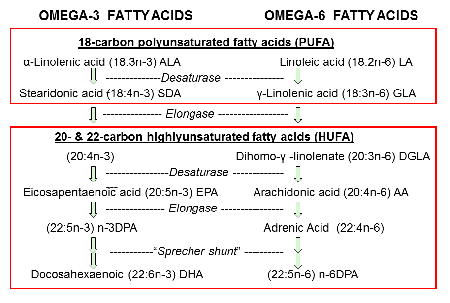 The 18-carbon omega-3 and omega-6 polyunsaturated fatty acids (PUFA) are present in plants and vegetables. Leafy plants tend to have similar amounts of omega-3 and omega-6, but seeds and nuts tend to have much more omega-6 than omega-3 .
The 18-carbon omega-3 and omega-6 polyunsaturated fatty acids (PUFA) are present in plants and vegetables. Leafy plants tend to have similar amounts of omega-3 and omega-6, but seeds and nuts tend to have much more omega-6 than omega-3 .
The longer 20- and 22-carbon highly unsaturated fatty acids (HUFA) occur mostly in animal tissues. They accumulate from metabolism of the EFA in the foods that the animals eat. Seafoods tend to have more omega-3 HUFA than omega-6 while grain-fed farmed animals tend to have more omega-6 HUFA than omega-3. The balance of n-3 and n-6 HUFA in our tissues is a good health risk assessment biomarker, because it affects the intensity of converting HUFA into potent hormone-like eicosanoids that control human physiology many immune-inflammatory conditions.
The Omega 3-6 Balance Score helps you Nix6 and Eat3.
 The omega-6 EFA grow longer (and more double bonds are added) during metabolism of linoleic acid, the most abundant essential fatty acid in American foods. The competing omega-3 HUFA are formed from alpha-linolenic acid, the major omega-3 nutrient in plants. Foods from the oceans, like fish and shellfish, contain appreciable amounts of all of the omega-3 nutrients. The Omega 3-6 Balance Score for each of over 5,000 different food items is useful for planning meals, shopping or talking about foods with friends. Seafoods have the most positive balance scores of all the food groups. New functional foods with more positive Scores can help people maintain wellness and reduce the need for treatments,
The omega-6 EFA grow longer (and more double bonds are added) during metabolism of linoleic acid, the most abundant essential fatty acid in American foods. The competing omega-3 HUFA are formed from alpha-linolenic acid, the major omega-3 nutrient in plants. Foods from the oceans, like fish and shellfish, contain appreciable amounts of all of the omega-3 nutrients. The Omega 3-6 Balance Score for each of over 5,000 different food items is useful for planning meals, shopping or talking about foods with friends. Seafoods have the most positive balance scores of all the food groups. New functional foods with more positive Scores can help people maintain wellness and reduce the need for treatments,
updated September, 2017
